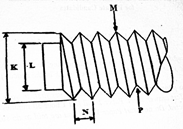Question 1
(A)
The figure above shows parts of a thread.
(i) Identify the parts labelledK, L, M, N and P;
(ii) Explain the parts labelledM, N and P.
(b) State two differences between hollowing and raising.
Observation
Some of the candidates could not correctly identify the labelled parts. The required responses to the question are as follows:
1(a)
(i) K – Nominal, major or outside diameter
L – Core, minor or root diameter
M – Pitch
N – Crest
P – Root
(ii) M – Crest is the tip of the thread OR the highest point of the thread.
N – Pitch is the distance between two similar points on the thread OR the distance from a crest to the next one OR the space between two crests.
P – Root is the base of the thread OR bottom part of the thread.
(b) Two differences between hollowing and raising
In hollowing, metals are hammered into bowls or shallow dishes on a solid block or sandbag with the aid of hollowing hammer or bossing mallet. The process results in stretching and thinning of metal.
Deep shapes cannot be formed by using hollowing process and have to be raised.
In hollowing, the metal is stretched while in raising the metal contracts and becomes thickened. A raising hammer is used in conjunction with a round head stake or a raising stake.
